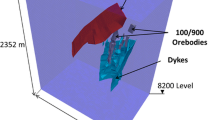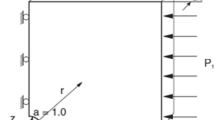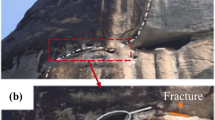Abstract
Fractures have a dominant effect on the mechanical response of a rock mass subjected to mining operations. A numerical finite element model describing the anisotropic property of elasticity and seepage was used in this study to assess the drift spacing at the Heishan metal mine in Hebei Province, China. The fractured rock mass is assumed to be transversely isotropic, and the influence of joint orientation on the anisotropic properties of elasticity of the surrounding rock mass around roadways was investigated. The associated stress field and fracture pattern of the surrounding rock mass were also numerically studied. The results indicate that the existence of joint planes greatly affects the stress field and fracture patterns, and the principal direction of joints can control the failure pattern of the surrounding rock mass around drifts.








Similar content being viewed by others
References
Aalianvari A, Katibeh H, Sharifzadeh M (2012) Application of fuzzy Delphi AHP method for the estimation and classification of Ghomrud tunnel from groundwater flow hazard. Arab J Geosci 5:275–284
Amadei B (1996) Importance of anisotropy when estimating and measuring in situ stresses in rock. Int J Rock Mech Min Sci Abst 33(3):293–325
Biot MA (1941) General theory of three-dimensional consolidation. J Appl Phys 12:155–164
Brady BHG, Brown ET (2004) Rock mechanics for underground mining. Springer, Netherlands
Chiu CC, Wang TT, Weng MC, Huang TH (2013) Modeling the anisotropic behavior of jointed rock mass using a modified smooth-joint model. Int J Rock Mech Min Sci 62:14–22
Hakala M, Kuula H, Hudson JA (2007) Estimating the transversely isotropic elastic intact rock properties for in situ stress measurement data reduction: a case study of the Olkiluoto mica gneiss, Finland. Int J Rock Mech Min Sci 44:14–46
Hoffman O (1967) The brittle strength of orthotropic materials. J Compos Mater 1:200–206
Jia P, Tang CA, Yang TH, Wang SH (2006) Numerical stability analysis of surrounding rock mass layered by structural planes with different obliquities. J Northeast Univ (Nat Sci) 27(11):1275–1278 (in Chinese)
Labiouse V, Vietor T (2014) Laboratory and in situ simulation tests of the excavation damaged zone around galleries in opalinus clay. Rock Mech Rock Eng 47:57–70
Li XL (2013) Timodaz: a successful international cooperation project to investigate the thermal impact on the EDZ around a radioactive waste disposal in clay host rocks. J Rock Mech Geotech Eng 5:231–242
Louis C (1974) Rock hydraulics. Rock Mechanic 165:299–387
Ma K, Tang CA, Li LC, Ranjith PG, Cai M, Xu NW (2013) 3D modeling of stratified and irregularly jointed rock slope and its progressive failure. Arab J Geosci 6:2147–2163
Martin SB, Erin H (2008) Application of rock mass classification techniques to weak rock masses: a case study from the Ruahine range, North Island, New Zealand. Can Geotech J 45:800–811
Safari HO, Pirasteh S, Pradhan B, Amid H (2013) Geohazards analysis of Pisa tunnel in a fractured incompetent rocks in Zagros Mountains, Iran. Arab J Geosci 6:1101–1112
Sharifzadeh M, Karegar S, Ghorbani M (2013) Influence of rock mass properties on tunnel inflow using hydromechanical numerical study. Arab J Geosci 6:169–175
Siahmansouri A, Gholamnejad J, Marji FM (2014) A hybridized numerical and regression method for estimating the minimum rock pillar width of twin circular tunnels. Arab J Geosci 7:1059–1066
Sun JP, Zhao ZY (2010) Effects of anisotropic permeability of fractured rock masses on underground oil storage caverns. Tunn Undergr Sp Tech 25:629–637
Tagarielli VL, Deshpande VS, Fleck NA, Chen C (2005) A constitutive model for transversely isotropic foams, and its application to the indentation of balsa wood. Int J Mech Sci 47:666–686
Tahmasebipoor A, Noorzad R, Shooshpasha E, Barari A (2012) A parametric study of stability of geotextile-reinforced soil above an underground cavity. Arab J Geosci 5:449–456
Terzaghi K, Peck RB, Mesri G (1996) Soil mechanics in engineering practice. Wiley, New York
Tien YM, Tsao PF (2000) Preparation and mechanical properties of artificial transversely isotropic rock. Int J Rock Mech Min Sci 37(6):1001–1012
Verma AK, Singh TN (2010) Assessment of tunnel instability—a numerical approach. Arab J Geosci 3:181–192
Vietor T, Li XL, Chen GJ, Verstricht J, Fisch H, Fierz T (2010) Small scale in situ tests: bore-hole experiments at HADES and Mont Terri rock laboratories. In: Deliverable 8 TIMODAZ project
Wang PT, Yang TH, Xu T, Yu QL, Liu HL (2013) A model of anisotropic property of seepage and stress for jointed rock mass. J Appl Math Vol. 2013, Article ID 420536
Yang TH, Xu T, Liu HY, Tang CA, Shi BM, Yu QX (2011) Stress-damage-flow coupling model and its application to pressure relief coal bed methane in deep coal seam. Int J Coal Geol 86(4):357–366
Yasitli NE (2013) Numerical modeling of surface settlements at the transition zone excavated by new Austrian tunneling method and umbrella arch method in weak rock. Arab J Geosci 6:2699–2708
Yu C, Deng SC, Li HB, Li JC, Xia X (2013) The anisotropic seepage analysis of water-sealed underground oil storage caverns. Tunn Undergr Sp Tech 38:26–37
Zarei HR, Uromeihy A, Sharifzadeh M (2012) Identifying geological hazards related to tunneling in carbonate karstic rocks - Zagros, Iran. Arab J Geosci 5:457–464
Zheng C, Yang TH, Yu QL, Zhang PH, Xia D, Liu HL, Li HZ (2012) Study on stability of underground rock mass in shirengou iron mine based on microseismic monitoring. Disaster Adv 5(4):1279–1284
Acknowledgments
This study was performed at Key Laboratory of Ministry of Education on Safe Mining of Deep Metal Mine, Northeastern University, Shenyang, China. The work presented in this study was financially supported by the National Basic Research Program of China (Grant No. 2013CB227902). The Natural Science Foundation of China (Grant No. 51174045, 51034001, 41172265, 51474051) and the specialized research fund for the Doctoral Program of Higher Education of China (Grant No. 20120042120053) also give financial supports to this research.
Author information
Authors and Affiliations
Corresponding author
Rights and permissions
About this article
Cite this article
Yang, T., Wang, P., Liu, H. et al. Deformational behavior of underground opening using a stress-seepage coupled model considering anisotropic characteristics. Arab J Geosci 8, 6635–6642 (2015). https://doi.org/10.1007/s12517-014-1723-1
Received:
Accepted:
Published:
Issue Date:
DOI: https://doi.org/10.1007/s12517-014-1723-1




